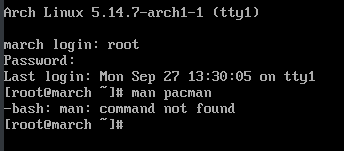A glace at Arch Linux (and I’m not happy with it!)
So, I finally took some time to try Arch Linux, a distribution that has a big momentum and is often accomunated to being for hackers.I have to say: I installed, booted, and decided it is not what I want for me.
And it’s not because of the installer, no way. It is because I don’t get the feeling of being comfortable using it.
If you find yourself at home using Arch Linux, please continue.
If you believe I’m not enough “hacker” to use it, please go browse away.
If you feel there is something less than awesome with Arch, please continue reading.
Look ma, I’m an hacker!
I often listen to podcasts and video tutorial that tell people how Arch Linux is great due to its basic command-line installer: “it will teach you how Linux works!”.True.
But if you have being around the Unix world for quite a long time, there is no hype here. I mean, after all the advatanges of Anaconda, Calamaris, and name another few, was that the sysadmin did not have anymore to type a quite long and difficult set of commands to format the hard drive, mount it, copy the software on it,
chroot into it, and so on. Quite frankly, I’ve done it enough times in the past, and today I don’t care really much about the installation process.
Clearly, this is great if you need or want to fully customize your installation process, but in the era of the virtualization, it sounds to me a lot faster to snapshot a virtual machine than to produce a fully customized installation script. Even if I feel more comfortable with the latter!
FreeBSD, and in general, all other BSDs, have basic installars, and can drop you into a shell to do whatever you want to your system during installation. A common case is to build a software RAID mirror before the system actually installs.
Therefore, in the long run, I don’t feel much impressed by the command line installer, and surely this is not what can push me towards or backwards Arch Linux!
The Installation Guide
Arch Linux has a very complete wiki, and the installation guide is a glorious resource.However, it looks to me not complete as expected. For example, there is no room for setting a boot loader, rather it just tells you “install a bootloader”, leaving the user to research which one to install and how to.
After all, the installation guide just list a set of commands to almost-blindly repeat on your installation to get it bootable.
I believe there is a great difference between being short and *being complete**, and this wiki page does not look to me as it is complete.
Moreover, the list of software suggested to be installed is really a skeleton part, and while I appreciate it, probably the user should have a couple of suggestions for extra software to install on the barebone system before it reboots.
The Documentation
While the Arch Wiki is great, after booting a freshly installed system a bad surprise happened to me:
The
man is not installed?
How am I supposed to learn how to interact on a system without
man installed?
I can search for within the wiki, but that’s not either a Unix approach, nor an “hacky” way. The system must be self-documented to let the administrator to work with it even in the dramatic situation where no internet is available!
I’m used to BSD systems here, and that’s a very good point of thos systems.
Pacman
The beloved package manager pacman.I’m sure it is great, but why it is asking me to use
-S at every time? And why this option is not explained in the base systsem lacking of the man?
I mean, if the
-S sync option is the preferred one, why is not enabled by default?
AUR
The Arch User Repository (AUR) is a set of user defined scripts that build and install third party software that has not been packaged yet (or will not be packaged).As an example, the following is the AUR script
PKGBUILD for pgbackrest:
# Maintainer: Shalygin Konstantin <k0ste@k0ste.ru>
# Contributor: Shalygin Konstantin <k0ste@k0ste.ru>
pkgname='pgbackrest'
pkgver='2.35'
pkgrel='2'
pkgdesc='Reliable PostgreSQL Backup & Restore'
arch=('x86_64')
url="https://github.com/${pkgname}/${pkgname}"
license=('MIT')
depends=('openssl' 'libxml2' 'icu' 'gcc-libs' 'xz' 'zstd' 'perl' 'postgresql-libs' 'libyaml' 'bzip2')
source=("$pkgname-$pkgver.tar.gz::${url}/archive/release/${pkgver}.tar.gz")
sha256sums=('ecaf8fc8ec68ac59143a7b4c0c53fded28d1e1396771a9456bb3fdca327e5718')
backup=("etc/${pkgname}/${pkgname}.conf")
build() {
cd "${srcdir}/${pkgname}-release-${pkgver}/src"
./configure \
--prefix="/usr"
make
}
package() {
cd "${srcdir}/${pkgname}-release-${pkgver}/src"
make DESTDIR="${pkgdir}" install
install -Dm644 ../LICENSE "$pkgdir/usr/share/licenses/$pkgname/LICENSE"
}
Despite the content, you can see how it does
make and install after a classical run of configure. I don’t want to over-simplify here, but again this reminds me something we already had: BSD ports!
As an example, the following is the FreeBSD port for the very same
pgbackrest package:
PORTNAME= pgbackrest
DISTVERSION= 2.33
CATEGORIES= databases
MAINTAINER= schoutm@gmail.com
COMMENT= Reliable PostgreSQL Backup & Restore
LICENSE= MIT
LICENSE_FILE= ${WRKSRC}/../LICENSE
LIB_DEPENDS= liblz4.so:archivers/liblz4
USES= gmake gnome pkgconfig pgsql ssl
USE_GNOME= libxml2
GNU_CONFIGURE= yes
USE_GITHUB= yes
GH_TAGNAME= release/${DISTVERSION}
WRKSRC_SUBDIR= src
ALL_TARGET=
CONFIGURE_ARGS= --with-configdir="${LOCALBASE}/etc/pgbackrest"
OPTIONS_DEFINE= ZSTD
ZSTD_LIB_DEPENDS= libzstd.so:archivers/zstd
ZSTD_CONFIGURE_OFF= ac_cv_lib_zstd_ZSTD_isError=no
ZSTD_CONFIGURE_ON= ac_cv_lib_zstd_ZSTD_isError=yes
post-install:
${STRIP_CMD} ${STAGEDIR}${PREFIX}/bin/pgbackrest
${MKDIR} ${STAGEDIR}${PREFIX}/etc/pgbackrest
.include <bsd.port.mk>
The difference is that the above is
Makefile, not a runnable script, but the idea is the very same: have a source to download and build on your system to get the software installed.
Conclusions
I truly believ Arch Linux is a very good operating system, simply I don’t see the hype in a system that gives me the same stuff I already have on my operating systems (e.g., BSDs) with less effort, same flexibility and, to some extent, a richer documentation.That’s why I’m not really interested in trying it unless I have enough spare time.